ALEC SOTH

A few years back, I enrolled in my first photography class. During the class, the professor handed out photobooks for us students to look through. I got Niagara, by Alec Soth. I thumbed through its pages, a little unimpressed. I wondered why Soth chose to photograph lonely people in rundown locations. I had been to the town Niagara Falls before and had been equally unimpressed. Yes, the waterfall was spectacular, but Niagara itself was depressing. And yet, both the book and the town made a lasting impression.

I’ve spent the last few weeks immersed in the online presence of Alec Soth. Last year, he created a YouTube channel dedicated to photography. I watched a couple of episodes and found them to be thoughtful and articulate; I will definitely be watching more. I also watched Martin Parr interview Soth (both Parr and Soth are members of Magnum) and found articles in The Guardian and The New York Times. One especially helpful article was “A Conversations with Alec Soth About Art and Doubt,” by Hanya Yanagihara. Finally, I examined his books, full of images of people and places. I’ve included photographs from four of his books: Sleeping by the Mississippi (2004), Niagara (2008), Broken Manual (2010), and I Know How Furiously Your Heart is Beating (2019). And I have revised my initial assessment of his work. After immersing myself more fully in photography, I am now seriously impressed.
(All quotes are taken from the above links.)

Alec Soth (born 1969) is from Minneapolis, Minnesota. I notice he likes to wear baseball caps. He wore one in Bristol, England, when being interviewed by Martin Parr. It might be a Midwestern thing; it’s definitely American. Soth is known for his contemporary American photographs (although he travels worldwide), so maybe the cap is justified. Soth’s career took off around 2004 when he published Sleeping by the Mississippi and was accepted into the 2004 Whitney Biennial, which, he says, opened many doors. From that point, “I was off and running.”
Photobooks are one thing Soth likes to talk about. Another thing Soth talks of is the power imbalance between photographer and subject, and the distance maintained between himself and the subject (this is not a reference to feet and inches).
Photography’s power imbalance is an oft-discussed topic. Is photography of people fundamentally exploitive? Richard Avedon acknowledged this problem, and Soth has thought about it too. Of his early work, Soth says that he was pushy, able to manipulate a situation for his “ego gratification.” Now he tries to be more thoughtful and seek a healthier balance. Even so, the photographer is the one in charge: “You can’t make art very effectively if you don’t take some measure of control. I can lead but I can also be respectful.”
That’s the easy part of the power imbalance, Soth says. Distribution is a harder ethical issue. “If a picture goes on a wall and it’s $25,000, that changes the meaning of the picture.” Soth’s portrait, “Charles, Vasa, Minnesota, 2002” sold at Sotheby’s for $37,500.

Soth also keeps a certain emotional distance from his subject. He states, “I don’t photograph people I know. The more I know you, the less likely I am to take your picture,” and, “I want to experience the person the way I experience an image.”
A portrait is a possession that stops time; it’s a representation that’s only part of a bigger something. In 2016, Soth stopped taking photographs, intent to live in the present “rather than try to possess it.” A year later, he returned to taking photographs. His 2019 book, I Know How Furiously Your Heart is Beating, includes a portrait of fellow photographer Nancy Rexroth. It is remarkably intimate for two photographers who deliberately keep their distance (Rexroth is “reclusive”). Soth’s photography keeps a feeling of “separation and social distance,” yet he enters his subjects’ most private spaces (bedrooms, bathrooms) and photographs them where they are most vulnerable. Distance and connection: it’s a unique combination; for Soth, and a paradox that works.

Like Soth, I like to wander around with my camera, just looking. On his Magnum webpage, Soth says, “I fell in love with the process of taking pictures, with wandering around finding things. To me, it feels like a kind of performance. The picture is a document of that performance.”
If I one day publish a photobook, and if Penn State Library purchases a copy, it’s possible that a photography freshman might one day leaf through its pages and wonder, like me, what it’s all about. Good work provokes thoughtful discussion, connects us to experience, and makes us wonder. Frequently, I head back to Soth’s YouTube channel and watch him talk, mostly about photobooks. I like photobooks and I like portraiture. Soth has given me plenty to think about.

